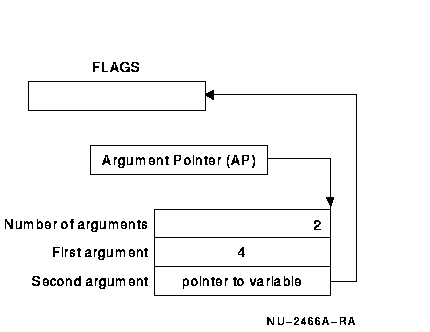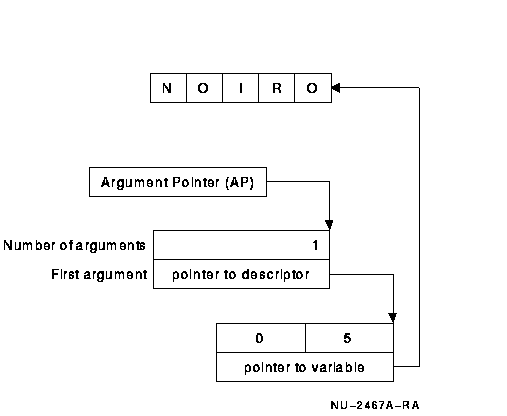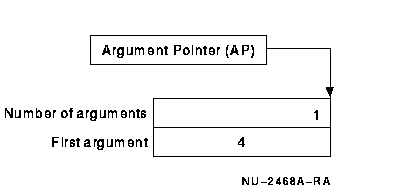Kednos PL/I for OpenVMS Systems
User Manual
11.2.1.2 Dummy Arguments for Arguments Passed by Reference
When PL/I passes an argument by reference, it places either
the address of the actual argument or the address of a dummy argument
in the argument list of the called procedure. PL/I creates a
dummy argument in the following cases:
- When the written argument is a constant or an expression
- When the written argument is enclosed in parentheses
- When the data type of the written argument does not match the data
type or precision specified in the parameter descriptor
In the last case listed above, PL/I issues an informational or
warning message and, for scalar arguments, creates a dummy argument of
the data type of the parameter. It places the address of this dummy
argument in the argument list. If the argument is an aggregate,
PL/I issues an error message; it does not create a dummy
argument for an array or for a structure.
In creating a dummy argument, PL/I performs the following
conversions:
Data Type of
Written Argument |
Data Type of
Dummy Argument |
|
BIT (unaligned)
|
BIT ALIGNED
|
FIXED BINARY (p,0) or
FIXED DECIMAL (p,0)
|
FIXED BINARY (31)
|
|
CHARACTER VARYING
|
CHARACTER NONVARYING
|
In all other cases, the data type of the dummy argument is the same as
the data type of the written argument.
11.2.1.3 Using Pointer Values for Arguments Passed by Reference
When an argument is passed by reference, PL/I places the
address of the actual argument in the argument list. This address can
be interpreted as a pointer value. In fact, you can explicitly specify
a pointer value as an argument for data to be passed by reference. For
example:
DECLARE SYS$READEF (ANY VALUE, POINTER VALUE),
FLAGS BIT(32) ALIGNED;
CALL SYS$READEF (4, ADDR(FLAGS));
|
At this procedure invocation, PL/I places the pointer value
returned by the ADDR built-in function directly in the argument list.
Figure 11-5 illustrates the argument list for the following example.
Note that the actual argument list in this example corresponds to the
argument list shown previously in Figure 11-4. Note also that
Figure 11-5 applies to the VAX platform only. Please see
OpenVMS Calling Standard for equivalent information for the OpenVMS Alpha platform.
DECLARE FLAGS BIT(32) ALIGNED;
DECLARE SYS$READEF (ANY VALUE, POINTER VALUE),
.
.
.
CALL SYS$READEF(4,ADDR(FLAGS));
|
Figure 11-5 Passing a Pointer Value as an Argument
(VAX)

11.2.1.4 Passing Arrays to a FORTRAN Routine by Reference
In FORTRAN, arrays must always be passed by reference; the array's
extents are, by custom, passed as separate arguments. The REFERENCE
attribute provides a convenient way to express an array parameter for
FORTRAN. For example:
FTNARRAY: PROCEDURE(X);
DECLARE SUM ENTRY ((*) FLOAT REFERENCE, FIXED BINARY(31))
RETURNS (FLOAT);
DECLARE (S, X(*)) FLOAT;
S = SUM(X, DIM(X));
|
SUM is a FORTRAN routine that sums the elements of a one-dimensional
array of floating-point numbers. Its second parameter is the number of
elements in the array.
11.2.2 Passing Parameters by Descriptor
When you pass a parameter by descriptor, the PL/I compiler
passes the address of a descriptor to the called routine. A
descriptor is a data structure that contains the address of a
parameter, along with other information such as the parameter's data
type and size.
For some structure parameters, PL/I passes an abbreviated form
of descriptor that contains only essential position and extent
information. In these cases, the address of the abbreviated descriptor
is placed in the argument list for the called routine. The use of an
abbreviated descriptor is transparent to you.
PL/I normally passes parameters by descriptor in the following
cases:
- When a parameter descriptor specifies a character string with an
asterisk length or an array with asterisk extents
- When a parameter descriptor specifies an unaligned bit string or an
array or structure consisting entirely of unaligned bit strings
- When a parameter descriptor specifies a structure containing any
strings or arrays with asterisk extents
For example, PL/I passes the arguments associated with the
following parameter descriptors by descriptor:
DECLARE UNSTRING ENTRY (CHARACTER(*)),
TESTBITS ENTRY (BIT(3)),
MODEST ENTRY (1,
2 CHARACTER(*),
2,
3 BIT(3),
3 BIT(3));
|
Figure 11-6 illustrates a character-string descriptor and shows how a
character-string argument is passed by descriptor. This example
illustrates the type of character-string descriptor used by system
services; this descriptor does not contain additional information
required by other classes of descriptors.
DECLARE NAME CHARACTER(5);
STATIC INITIAL ('ORION');
DECLARE SYS$SETPRN ENTRY
(CHARACTER(*));
.
.
.
CALL SYS$SETPRN(NAME);
|
Figure 11-6 Argument Passing by Descriptor

11.2.2.1 Passing Character Strings
When you declare a non-PL/I routine that requires a character-string
descriptor for an argument, specify the parameter descriptor as
CHARACTER(*). For example, the Set Process Name system service
(SYS$SETPRN) requires the address of a character-string descriptor as
an argument. You can declare this service as follows:
DECLARE SYS$SETPRN ENTRY (CHARACTER(*) OPTIONAL);
|
When a parameter is declared as CHARACTER(*), its written argument can
be one of the following:
- A character-string constant or expression
- A fixed-length character-string variable
- A varying character-string variable or a variable declared
CHARACTER(*) VARYING
For any of these arguments, PL/I constructs a character-string
descriptor and places its address in the procedure's argument list.
11.2.2.2 Passing Varying Character Strings
If you specify a varying character-string argument for a parameter
declared as (CHARACTER(*), the PL/I compilers issue a warning
message, construct a fixed-length character-string dummy argument, and
create a character-string descriptor for the dummy argument.
For an input argument, as in the example of the SYS$SETPRN service, the
dummy argument is acceptable. To suppress the warning message during
compilation, enclose the argument in parentheses. For example, if NAME
is a variable declared with the CHARACTER VARYING attributes, you can
specify it as an argument to the SYS$SETPRN system service like this:
CALL SYS$SETPRN ((NAME));
|
The parentheses around the argument NAME force PL/I to create
a dummy argument. The compiler does not issue a warning about a
nonmatching parameter and argument.
For a non-PL/I routine that returns a character string to a variable,
however, you cannot use a varying character string for an argument. If
the actual output argument is declared as VARYING and the parameter
descriptor specifies CHARACTER(*), PL/I creates a dummy
argument and the actual argument is not modified. Thus, for output
character strings passed by character-string descriptor, you must
choose one of the following:
- Specify a fixed-length character-string variable to receive the
string and a fixed-point binary variable to receive the length of the
string.
- Construct an actual character-string descriptor and pass the name
of the character-string descriptor as an argument. This technique is
described in Section 11.2.2.5.
In either case, you must include in your program the statements
necessary to determine the length of the string returned. For example,
the SYS$ASCTIM system service returns a character-string time value to
a character-string descriptor and returns the length of the string to a
fixed-point binary variable. These two arguments can be declared as
follows:
DECLARE TIME CHARACTER(63),
TIME_LENGTH FIXED BINARY(15);
|
After the call to this procedure, the following statement might output
the equivalence name returned:
PUT LIST ('Time is ',SUBSTR(TIME,1,TIME_LENGTH));
|
The PUT statement uses the SUBSTR built-in function to obtain the
length of the string returned in the variable TIME_LENGTH by SYS$ASCTIM.
11.2.2.3 Using ANY CHARACTER(*)
You can use the ANY CHARACTER(*) declaration to declare parameters for
routines that can handle both fixed- or varying-length strings for a
single parameter. The declaration allows either VARYING or NONVARYING
strings to be passed without the creation of a dummy argument.
Essentially, all OpenVMS system routines, with the exception of the
system services and Librarian Utility routines, can accept string
parameters of this type.
Note that routines written in other languages do not allow strings to
be passed using this method by default. The routine being called must
explicitly use LIB$ANALYZE_SDESC (or an equivalent routine) for this
declaration to work correctly.
You can use the ANY CHARACTER(*) attribute as shown in the following
example:
%INCLUDE $STSDEF;
DECLARE FIXED_STRING CHAR(22),
VARYING_STRING CHAR(80) VARYING;
DECLARE LIB$DATE_TIME ENTRY(
ANY CHARACTER(*))
RETURNS (FIXED BINARY(31));
STS$VALUE = LIB$DATE_TIME(FIXED_STRING);
STS$VALUE = LIB$DATE_TIME(VARYING_STRING);
|
In both of these cases, the string contains the output value, since no
dummy argument is required.
11.2.2.4 Using ANY DESCRIPTOR
The ANY and DESCRIPTOR attributes can be used together for routines
that can process any valid data type descriptor. Routines of this type
are few; however, LIB$CVT_DX_DX and the routine DTR$COMMAND in the DEC
DATATRIEVE layered product callable interface allow any valid data type
descriptor. For these routines, declarations should be as follows:
DECLARE LIB$CVT_DX_DX ENTRY(
ANY DESCRIPTOR,
ANY DESCRIPTOR,
FIXED BINARY(15) OPTIONAL TRUNCATE)
RETURNS(FIXED BINARY(31));
DECLARE DTR$COMMAND ENTRY(
1 LIKE DTR_ACCESS_BLOCK,
ANY CHARACTER(*),
ANY DESCRIPTOR LIST TRUNCATE);
|
11.2.2.5 Passing an Actual Descriptor
To pass an actual descriptor as an argument, you must take the
following steps; the keyed numbers correspond to the callout numbers in
Example 11-1.
- In the parameter descriptor for the called
procedure, declare a structure in the format of a descriptor for the
argument that is to be passed by descriptor, specify ANY in the
parameter descriptor, or use
the REFERENCE built-in function to override the parameter declaration
at the point of the call.
- Declare a structure variable in your program
whose members and attributes correspond to the structure declared in
the parameter descriptor for the argument.
- Assign values to the members of the structure
variable providing the required information. For a character-string
descriptor, you must provide the length of the string and a pointer to
the variable containing its value.
- Pass the name of the structure variable as an
argument in the procedure invocation.
The Set Process Name system service (SYS$SETPRN) shown in Example 11-1
requires a text name string to be passed by descriptor. The structure
variable NAME_DESC is a character-string descriptor; its members
describe the length and location of the character-string variable
NEWNAME. The value of NEWNAME is the actual argument passed to the
procedure. Note that the call in this example is equivalent to the
example shown in Figure 11-6 of passing an argument by descriptor.
| Example 11-1 Writing a Character-String
Descriptor |
DECLARE SYS$SETPRN ENTRY (CHARACTER(*));(1)
DECLARE 1 NAME_DESC,
2 NAME_LENGTH FIXED BINARY (31),(2)
2 NAME_ADDRESS POINTER;
DECLARE NEWNAME CHARACTER (5) STATIC INITIAL ('ORION');
NAME_DESC.NAME_LENGTH = LENGTH(NEWNAME);(3)
NAME_DESC.NAME_ADDRESS = ADDR(NEWNAME);(3)
CALL SYS$SETPRN(REF(NAME_DESC));(4)
|
Note that this example can be simplified if SYS$SETPRN is declared as
follows:
DECLARE SYS$SETPRN ENTRY (ANY);
|
All other variables would be the same as in Example 11-1, although the
use of the REFERENCE built-in function could be omitted.
In most cases, the first method is preferable because it allows the
declarations in PLI$STARLET to be used consistently; the only cases in
which special handling is required is for those calls that require it.
11.2.3 Passing Parameters by Value
When you pass a parameter by value, the PL/I compilers pass a
copy of the parameter's value to the routine instead of passing its
address. Because only a copy of the parameter's value is passed, the
routine does not have access to the storage location of the parameter.
Therefore, when you pass a parameter by value, any changes that you
make to the parameter value in the called routine do not affect the
value of that parameter in the calling routine.
For an argument to be passed by value, you must use the VALUE attribute
in a parameter description. The following declaration of the external
entry VHF illustrates a declaration for an external routine that
receives its parameter by value.
DECLARE VHF ENTRY (FIXED BINARY(31) VALUE);
|
You can also define PL/I procedures that receive arguments by
value. To do this, you must specify the VALUE attribute in the
declaration of the parameter. For example, the corresponding definition
of the routine VHF would be as follows:
VHF PROCEDURE (LENGTH);
.
.
.
DECLARE LENGTH FIXED BINARY(31) VALUE;
|
The following code example and Figure 11-7 illustrate argument
passing by value.
DECLARE VHF ENTRY(
FIXED BINARY(31) ANY VALUE);
.
.
.
CALL VHF(4);
|
Figure 11-7 Argument Passing by Immediate Value

Arguments that can be passed by value are limited to the following data
types, which can be expressed in 32 bits.
- FIXED BINARY(m), where m is less than or equal to 31
- FLOAT BINARY(n), where n is less than or equal to 24
- BIT(p) or BIT(p) ALIGNED, where p is less than or equal to 32
- ENTRY
- OFFSET
- POINTER
No other data types can be passed by value. Note that when ENTRY VALUE
is specified in a parameter descriptor, only the entry points of
external routines may be passed by value.
A complete entry value for an internal routine requires two longwords,
one for the parent frame and one for the 32-bit entry-point address.
When you specify the VALUE attribute in a parameter descriptor, you can
specify the ANY attribute instead of declaring any data type
attributes. For example, the declaration of VHF can appear as follows:
DECLARE VHF ENTRY (ANY VALUE);
|
At the time of the procedure's invocation, PL/I converts the
written argument as needed to create a longword dummy argument.
11.2.3.1 Dummy Arguments for Arguments Passed by Value
For arguments to be passed by value, PL/I always creates a
dummy argument directly in the argument list for the called procedure.
If the parameter descriptor is specified with the ANY and VALUE
attributes, dummy arguments are created with the following data types:
Data Type of
Written Argument |
Data Type of
Dummy Argument |
FIXED BINARY, (p,0) or
FIXED DECIMAL (p,0)
|
FIXED BINARY (31)
|
|
BIT or BIT ALIGNED
|
BIT (32) ALIGNED
|
|
ENTRY
|
ENTRY
|
|
OFFSET
|
OFFSET
|
|
POINTER
|
POINTER
|
If a parameter descriptor is specified as VALUE with a particular data
type (as opposed to being specified as ANY), a dummy argument of that
data type is always created, and the written argument is assigned to
the dummy. The written argument must be valid for conversion to the
data type specified in the corresponding parameter descriptor.
11.2.4 Special Parameter Attributes
PL/I provides the LIST, OPTIONAL, and TRUNCATE parameter
attributes.
- The LIST attribute indicates that the specified list can be invoked
with a list of arguments for the last parameter.
- The OPTIONAL attribute indicates that optional arguments will not
be specified in the entry invocation.
- The TRUNCATE attribute indicates that the argument list may be
truncated at a specified position.
Each of these attributes is described in the following sections.
11.2.4.1 LIST Attribute
Although most system routines and procedures require a specific number
of arguments, some routines accept an unspecified number of optional
arguments. To declare these routines in a PL/I program so that
you can invoke them with differing numbers of arguments, you must
declare the last parameter with the LIST attribute. The last parameter
descriptor given in the ENTRY attribute is used for extra arguments.
The Formatted ASCII Output system service (SYS$FAO) is an example of a
procedure that has a variable-length argument list. It can be declared
as follows:
DECLARE SYS$FAO ENTRY (CHAR(*), FIXED BINARY(15) OPTIONAL,
CHAR(*), ANY VALUE LIST TRUNCATE);
|
This parameter descriptor specifies only four arguments. When SYS$FAO
is invoked with more than four arguments, PL/I uses the
parameter descriptor of the last parameter (ANY VALUE) to pass all the
additional arguments. If any argument that will be specified is not to
be passed by value, you must specify a parameter descriptor for the
argument in the declaration.
Note
The LIST attribute is valid only for parameter descriptors.
|
11.2.4.2 OPTIONAL Attribute
Some PL/I and non-PL/I routines with fixed-length argument
lists accept optional arguments and provide a default action if no
value is specified for the optional argument. When an optional argument
is not specified, its corresponding argument list longword is filled
with a value of zero passed by immediate value.
In PL/I , you can omit the specification of an optional
argument in a written argument list as long as you enter the correct
number of commas to ensure that the argument list will have the correct
number of longwords. You can indicate that you are not specifying an
optional argument in either of the following ways:
- Omit the argument from the argument list.
- If the argument is to be passed by immediate value, specify a zero
for the written argument.
In the case of trailing arguments all of which have the OPTIONAL
attribute, you do not need to specify the commas, although you might
choose to do so to add clarity for people who read your source code.
But if you do not specify commas, the compiler will automatically
create null parameters for trailing formal parameters that have the
OPTIONAL attribute, ensuring that any requirement for a minimum length
argument vector is met, for instance in the case of VMS system services.
For example, an argument list that has three optional arguments can be
written as follows:
The called procedure must detect and interpret the optional parameters
in the argument list. The following example illustrates optional
arguments omitted from an argument list:
DECLARE SYS$ASCTIM ENTRY (
FIXED BINARY(15) OPTIONAL,
CHARACTER(*),
ANY OPTIONAL,
BIT(1) ALIGNED VALUE OPTIONAL),
TIME_STRING CHARACTER(24);
.
.
.
CALL SYS$ASCTIM(,TIME_STRING,,);
.
.
.
CALL SYS$ASCTIM(,TIME_STRING);
|
This call to the service SYS$ASCTIM specifies only the second argument;
the argument list contains four arguments. When you specify a null
argument, as in either of the cases above, PL/I always places
a zero in the argument list passed to the called procedure.


